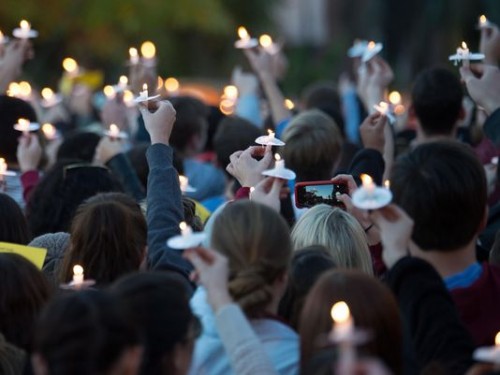Teaching Active Shooter Preparation
There was a shooting on my campus. A lone gunman entered the first floor of the library last week in the middle of the night and started randomly shooting. Three students were injured and hundreds more hid in the stacks while campus police ended the attack by killing the shooter. As a sociologist, I know too well how our culture has a way of pushing people to the point of breaking, and that the topics taught in a sociology classroom may infuriate some students. Therefore, along with a discussion on appropriate classroom behavior, I give my students a “threat to the classroom” lesson at the beginning of each semester.
Posting the lesson here is my way of reclaiming the FSU library and learning environments generally. I developed this lesson for my classrooms from the information posted on Department of Homeland Security Active Shooter Preparedness training site. Because each classroom is unique you will have to develop a new plan for each new environment. The students will help but generally think about the differences between a first floor auditorium classroom or an 8th floor computer based classroom.
I should say that I do not think it is part of my job description to keep my students from harm. I do think it is in my job description to provide a safe environment for students to learn. In the case of an emergency I accept my role as leader of the classroom and am determined to be prepared with a plan should I ever need one.
Goal/Aims/Objectives: Survive an active shooter event.
Resources/Materials:
- Know your campus and classrooms well.
- The building in which I teach has electronic locks on all the doors. I have the ability to lock the doors to my classroom with my swipe card. Each semester I contact technology resources to register with the building. I also ensure that my card works on site. Practice using the fancy locks. Keep your swipe card or keys on your desk for easy access.
- I can turn the lights on and off from the computer in the front of the classroom. This also requires practice. Do it. Practice toggling between screens. Turn the lights off and on while talking. Turn them off with purpose. Practice using a calm face and direct eye contact.
- Program all emergency numbers into your phone now. This includes campus police and the technology department. You never know what assistance can be provided from a distance.
- Get in touch with campus police to find out if there are any trainings or preparation courses designed for instructors that are specific to your location. Attend those courses. If courses are not on your campus yet, contact other local campuses to see if they can provide additional resources. I got many of these tips from a Georgia college located about 40 miles north of Tallahassee. If you learn code words, periodically call campus police to make sure the code words are still active (more on this later).
- Know your emergency exits. Know where they go. Have you used every stairwell in your building? I have. I know that the north stairwell on the west side of the building provides cover all the way out onto the walkway heading away from the building while the south stairwell on the west side of the building unceremoniously deposits students directly into the main common area on the ground floor. NOT the place I want to be in an active shooting situation. Move your booty and climb those stairs.
- Finally, get to know as many student’s names as possible. You may need to give specific instructions quickly. The goal here is to be clear, calm and direct. In this case, say the names without necessarily looking at the students (you might be turning off the lights). Know the students who sit closest to the doors.
Opening: For this portion of the lesson I write on the board: “[Classroom number] External Threat Plan”. I begin by asking if any of the students have military or weapons training. I have them raise their hands or stand up so all the students can identify them. I charge them specifically with recognizing gunfire. While I love skeet shooting and have fired a hand gun a couple times in my life, I have never heard the report of an AK47 or a silenced Beretta M9. Inevitably these students snicker and say that “of course I will also know the sound of gunfire when I hear it”. I doubt them and put them in charge of listening. They probably understand firing distances, reloading, misfires, the sound of bullets crashing into walls, etc…
Then I show them Run, Hide, Fight: Surviving an Active Shooter Event released by Homeland Security.
Activity #1:
- Get the students working as a team. No better ice breaker huh?
- With the header on the board I ask the students for suggestions for our external threat plan. I spent the first couple of semesters dictating a plan but I got blank terrified stares in return. Obviously this is not what I wanted. So now I prompt with: “What should we do first?” “Can we run? (why or why not)”, “Where should we hide?”, “What do we do with our stuff?”
- The board begins to fill with a list of ideas like turn off the lights, lock the doors, barricade the doors, hide against the walls or under our desks, silence our cell phones, use the fire extinguisher as an improvised weapon, etc…With each suggestion I expand and ask students questions of preparation.
- The students get up out of their seats and manually turn off the lights. (We have flat button light switches that are right next to the flat button air conditioning switches – it can be confusing.) They go outside the classroom and look inside the narrow window to determine the best place to hide. We have even stacked desks against doors just to make sure we know how heavy they are and that it can be done without creating racket or impeding our escape.
- Once we have a well thought out plan on the board I have the students vote on it and we agree to remember it in the event of an emergency. Usually at this point the students are still completely freaked out but feel more confident. I promise. No one forgets the plan. I periodically ask about the plan on a quiz. Every single student gets it correct.
I do address students carrying guns to stop the shooter. I tell them to go ahead and be a hero but that is not part of our collective plan. We will barricade the doors behind them. I do not want to know who has a concealed weapon. Just like I do not want to know what time they stopped drinking this morning. Both, in my opinion, are not conducive to learning. I leave it there and do not open the floor for discussion.
Activity #2:
- Recognize and immediately address feelings of fear or insecurity. Troubled students or an out of place member of the larger community may be the source of an internal threat – or a threat that is already present in the classroom.
- First I have everyone take out their cell phones. I ask that they program campus police into their phone with the code word “NORA” in the contact name line. NORA stands for “Need Officer Right Away” and is a campus wide code word. Call your campus police to find out which emergency word they use. I tell them that if I ever say the word NORA in a sentence – such as during an after class conversation that somehow makes me uncomfortable – that they should immediately leave and call police.
- If the student is on the line with the police department and the threatening student is still in earshot they can ask about “NORA’s health” or whether “NORA will attend dinner tonight” and the police department will trace the call and arrive shortly.
- The key to internal threats is to get the students to recognize their own feelings of safety and to immediately exit leaving their belongings. We talk about how they “know” they are unsafe. What are usual physical warning signs? I ask them to share stories of times they have felt unsafe on campus and what they do when that feeling arises.
- Finally, we talk about classroom situations where they felt most uncomfortable. These are the most common responses: inebriated students behaving oddly, overly loud or space invading students, demanding and condescending students, and those students who don’t adhere to typical grooming standards.
- I make myself available for student concerns and have reported uncomfortable student behavior in the past. I also keep the counseling center’s phone number programmed into my phone so I am prepared in case someone needs to talk or we need advice for how to address erratic behavior.
I contact campus police at the beginning of each semester to see if they have any new information. Alas…every semester I am given a few “pointers” but am pretty much on my own – hopefully that will change. They did provide the Run, Hide, Fight video. Campus police remind me to emphasize their role in a shooting situation so I take a moment to tell students that police officers are there to secure the area and apprehend the shooter. They will not assist with evacuation or tend to injuries until the area is secure. While police officers are the first on the scene they may not provide the kind of assistance students expect.
This is such an important topic that I feel it needs coverage right along with my syllabus. My students know what to do in the event of a fire or a tornado. They should feel just as prepared in the case of a threat to the classroom. As students on the Florida State campus in Tallahassee reclaim their university from random violence, I hope administrators and security personnel will assume a leadership position and implement thoughtful emergency training for possible future threats.
Additional Materials:
This video was just posted in May of 2014. The dramatized situation is staged in a library. NOT appropriate for my campus but may be helpful for others. Ps. This video is terrifying!
General preparedness training not specific to classroom settings:
http://www.dhs.gov/sites/default/files/publications/active_shooter_educational_booklet_508.pdf
http://www.dhs.gov/video/options-consideration-active-shooter-preparedness-video
Some sample university preparedness plans:
http://www.sandiego.edu/emergency/procedures/campus-active-shooter.php
http://www.tamu.edu/emergency/procedures/shooter.html
http://www.colby.edu/campus_cs/security/emergency/emergency-procedures.cfm





